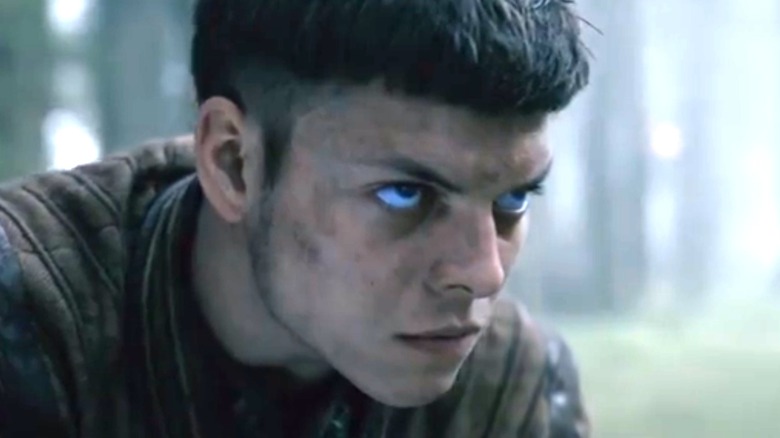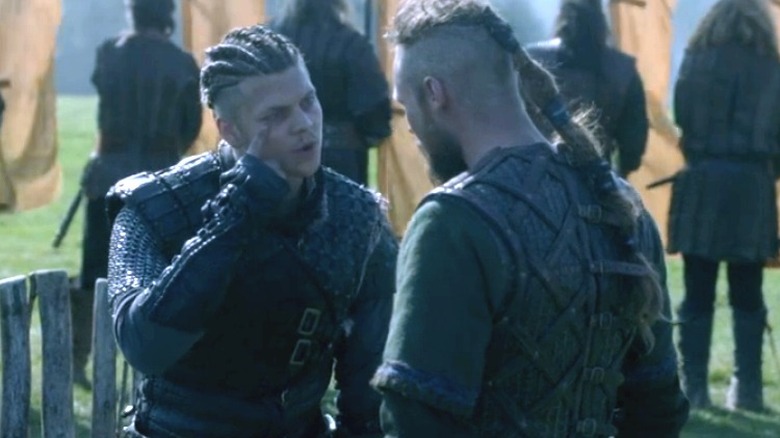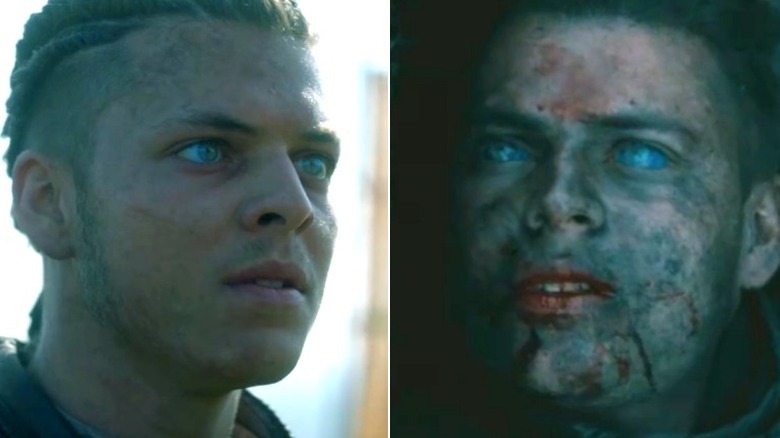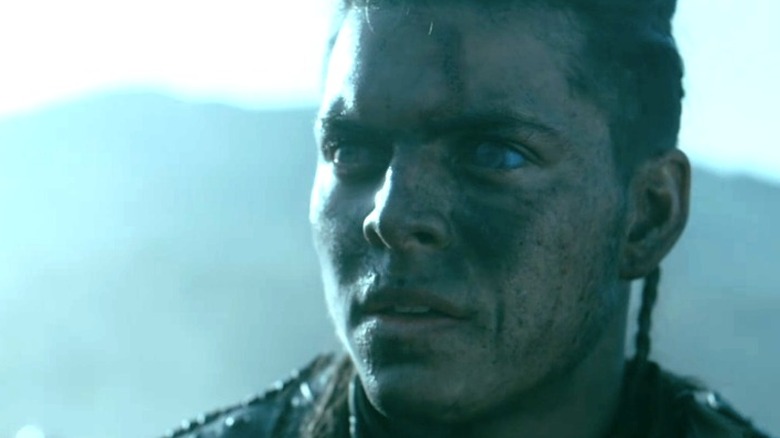Why Ivar's Eye Color In Vikings Has More Meaning Than You Think
Though the first four seasons of History and Michael Hirst's "Vikings" revolved around the legendary Ragnar Lothbrok (Travis Fimmel), by Season 5, his sons had taken center stage. Following Ragnar's Season 4 death, the series introduced fully-grown versions of Bjorn (Alexander Ludwig), Ubbe (Jordan Patrick Smith), Hvitserk (Marco Ilsø), Sigurd (David Lindström), and, of course, Ivar (Alex Høgh Andersen). Of all Ragnar's sons, it's inarguably the alternately sympathetic and psychopathic Ivar who serves as the latter seasons' most compelling on-again, off-again antagonist.
Like his partially mythological father before him, the real-life 9th century Viking, warrior, and chieftain upon whom Andersen's character is based boasts a record wherein the line between history and legend is intentionally nonexistent (via Britannica). What's more, thanks to a combination of the exaggeration, mistranslation, and (in certain texts) bias that permeates what limited historical source material we've discovered thus far, there's much we don't know (or that's still open to debate), about the real-life Ivar — including the meaning of the moniker "boneless."
Both despite and as a result of this factual void, Hirst had to make a number of decisions about who Ivar was, what he might have looked like, and how he might have operated. Andersen's Ivar, for instance, has piercing blue eyes that grow more intense in response to the state of his body. Surprisingly, this fictitious character trait is actually rooted in reality.
Ivar's eyes have both a medical and a historical basis
While historians have several explanations for Ivar's perplexing title (e.g, that it's ironic, or that it's a comment to his agility in battle, or a reference to his impotence, or a mistranslation of the Latin word for "detested," as outlined in University Press' "Ivar the Boneless: Viking Warrior") many have interpreted it to mean he had brittle bone disease, otherwise known as osteogenesis imperfecta.
This literal reading of the name stems largely from a passage in The Saga of Ragnar Lothbrok, commonly translated as follows: "... the boy was ... given the name Ivar. But the boy was boneless, and it felt as though there was only gristle where the bones would be" (Crawford, J. 2017 "The Saga of the Volsungs with The Saga of Ragnar Lothbrok," page 97).
It's this most literal understanding that Hirst chose to use in his depiction, and that, by all appearances, prompted him to write in Ivar's alternating eye-color. In the series, Ivar's eyes are an indicator of his physical vulnerability. The bluer they appear, the more likely he is to break a bone. There are a handful of references to this phenomenon, including a discussion between Ivar and Ubbe in Season 5, Episode 8, wherein Ivar says, "You remember I had to ask you ever single morning how blue the whites of my eyes were, because if they were very blue I was in great danger of breaking a bone."
That Ivar refers to the "whites of my eyes" and not just "eyes" is relevant.
Blue sclera is an actual symptom of Ivar's disorder
There are a number of "types" of Osteogenesis imperfecta, and its symptoms vary both from type to type and within each type (via Hopkins Medicine). One potential symptom of the milder, type I form of the disorder (the variation Ivar has in the series) is a blueish discoloration of the sclera, or, the white part of the eye (via National Library of Medicine).
As the Kerala Journal of Ophthalmology explains, "The characteristic blue sclera is caused by thinness and transparency of the collagen fibers of the sclera that allow visualization of the underlying uvea." In other words, the sclera itself doesn't change color, nor does it do so to varying degrees from day-to-day, as shown in the series. In reality, it's merely made more transparent as a result of the disorder's effect on type I collagen (via NIH), allowing the blue part behind to show through.
This effect appears most drastically in the "Vikings" series finale. Prior to "The Last Act," the blue discoloration is limited to Ivar's irises, but just before and immediately after Ivar is killed in battle, the blue appears in both the sclera and the iris. Though the vibrancy with which the series depicts this symptom in the fearsome Ivar gives him an unrealistic, otherworldly appearance — in keeping with his teased relation to the gods — it's a clear attempt to imbue the character with at least one trait realistic to his potentially historical condition. However ...
Ivar's eye color is doing a lot of work for the series
That said — and the series' use of blue sclera notwithstanding — it's important to note that some feel it failed in its depiction of the disorder for other reasons. In a 2017 interview with the Disability Visibility Project, advocates Jan J. and Vilissa K. Thompson, both of whom have osteogenesis imperfecta, shared their thoughts about Ivar, and the depiction of OI in the show. Both mentioned the fact that, as an adult, Ivar never actually grapples with his variation of the disorder's most dangerous consequence.
"[I] would have really liked to see the show continue with, and visibly play out, the top OI symptom of the danger and experience of his bones fracturing as an adult," Jan told the outlet, while Thompson added that fractures heal and present differently in adults than in children. And though this interview did take place prior to Season 6, it still stands that the only time Ivar actually breaks or fractures any bones occurs during his death in battle. Moreover, while both women had plenty of positive things to say about the way Ivar's character is written, as Thompson notes, it is yet another example of "cripping up" (a non-disabled actor playing a disabled character, per The Guardian). "There are actors with OI who are better suited for these roles," Thompson said.
Since so much of what would have been required to properly portray OI in the series simply isn't there, Ivar's vaguely medically accurate eye color does more heavy lifting than the average character trait.



